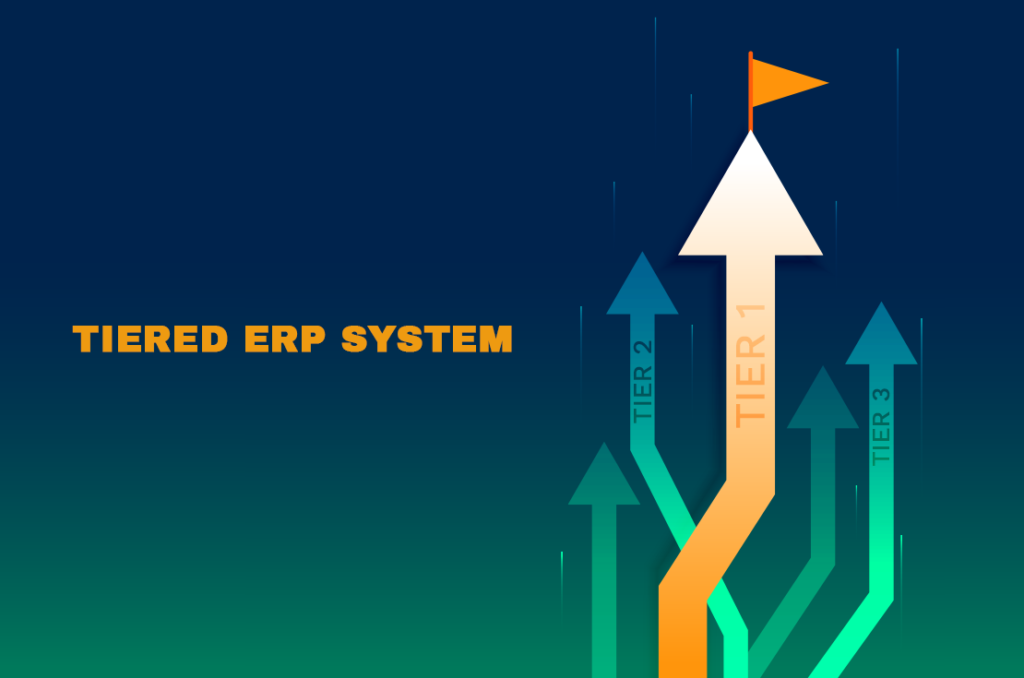Tiered enterprise resource planning (ERP) systems can be one in a long line of solutions that companies implement when they undertake digital transformation. To understand what tiered ERP means, it would help to roll back the clock and understand ERP solutions before the advent of cloud computing.
What Is An ERP System
The ERP system in its present incarnation is an itinerant of the material requirements planning (MRP) system that came into existence during the third industrial revolution in the late 1960s and early 1970s right through to the late 1990s.
The MRP catered towards businesses in manufacturing and related industries. Its prime objective was to help enterprises manage inventories, scheduling, shop floor control, delivery to customers, and a whole range of other activities critical to the manufacturing industry.
On the other hand, the ERP system is an all-encompassing business processes solution that caters to organisations from various industries instead of just the manufacturing industry. ERP systems provide solutions to manage the finances, customer relationship management (CRM), project management and other functions critical to the operations of any business.
The main allure of the ERP system lies in its ability to consolidate all the aforementioned business processes and offer company owners a unified view of their organisation. When data from disparate sources are integrated and presented in one platform, such as an ERP system, business owners have the opportunity to make informed decisions based on a 360-degree view of their company’s processes.
What Is a Tiered ERP System
In its traditional sense, the tiered system divides ERPs into three categories based on the size of an organisation, the complexity of its transactions, its yearly revenue, and the comprehensivity of the ERP solution required for the business.
Tiered ERPs in the Legacy, pre-Cloud, pre-SaaS Era
Tier 1 ERP
Legacy Tier 1 ERP systems were traditionally catered towards big enterprises and corporations with subsidiaries in different parts of the world. Generally, Tier 1 ERP systems are built to process the complex transactions that characterise big businesses – some of them, although not all – who may need an ERP system with robust functionalities, especially those that help them with multi-company consolidation.
Before the arrival of cloud computing and the Software-as-a-Service (SaaS) model, legacy Tier 1 ERPs were strictly the preserve of big corporations with subsidiaries or businesses whose revenues are in the millions. Because it is aimed at resolving the business processes of big enterprises, the legacy Tier 1 ERP system was one that was costly. This meant an exhaustive requirement analysis was needed to customise or configure the ERP system to suit the needs of each business.
Tier 2 ERP
Before the advent of cloud computing, tier two ERP systems catered to medium-sized businesses. The functions provided by legacy Tier 2 ERP vendors focused more on core business needs such as finance, sales and marketing, HR and supply chain management.
Tier 2 ERP systems were predicated on less complex architecture, thus enabling businesses to request for customisations according to their business needs. For instance, a medium-sized manufacturing company may opt for a customised Tier 2 ERP system to ensure that functionalities such as shop floor control, planning and scheduling, and procurement are incorporated as part of the implementation.
Tier 3 ERP
Tier 3 ERP systems cater to small businesses that only need the most basic solutions. The ERPs in this tier also allow plenty of room for customisations, as they are smaller and less complex systems. Tier 3 ERP systems benefit businesses in specific niche markets who find that most mainstream systems do not cater to their specific needs.
The Evolution of Tiered ERP in the Age of Cloud and SaaS
The arrival of cloud technology upended how businesses operate and ushered in an extremely disruptive and competitive business environment. Much of the reason behind this lies in the agility and scalability of operating on the cloud.
This has allowed businesses to respond swiftly to changing consumer needs and market trends, as the cloud architecture is flexible, customisable, and configurable to the needs of each company. Cloud systems’ scalability also ensures businesses accrue savings from not having an in-house IT team to manage their servers and performing costly updates to suit their changing business needs.
Cloud computing also heralded the emergence of the SaaS business model where companies pay a subscription fee for solutions they need without having to worry about the maintenance costs that comes with having an in-house server.
Tiered ERP in The Era of Cloud Computing and The Rise of Hybrid ERP
While the definition of the different tiers in ERP remains the same, how they are implemented in the cloud ERP era are different. For instance, a company with a presence in different parts of the world may have a legacy Tier 1 ERP system that it uses at the headquarters level for multi-company consolidation.
The company can elect to implement a specific cloud ERP module that best addresses the needs of its subsidiaries. This Tier 2 cloud ERP module may address a variety of functions that are especially important for the company’s subsidiaries, such as CRM or Sales and Marketing and other functions..
These two tiers – the legacy Tier 1 and cloud Tier 2 – can then be integrated so that the flow of information can be automated without the need for manual entry of data. This integration ensures there is no data duplication, enables automation and allows businesses to operate on their complex tier one legacy systems that have been customised and configured to suit their business needs.
The implementation of a multi-tiered ERP system such as this is also known as hybrid ERP. The hybrid ERP approach allows businesses with multiple entities who have spent much time and resources to configure their legacy systems to take their first steps towards digital transformation, by moving their less complex entities to a cloud ERP system initially before going to a full-on cloud ERP system.
In a Nutshell
Digital transformation is an inevitability all businesses are starting to embrace. Sixty-four percent of respondents in a Gartner study on finance organisations revealed the intent to invest in a cloud ERP system in the next three years.
The emergence of the SaaS models presents companies with the luxury of choice which may not have necessarily been available 10 or even five years ago. Businesses now can choose an ERP solution that suits their business needs and integrate it with their existing solutions. In the long run, however, we will see more and more businesses implementing Tier 1 ERP systems as their business grows in an increasingly digital business environment.
Oracle NetSuite
Oracle NetSuite is a true-cloud ERP system that provides companies with a consolidated view of their business processes and automate key workflows.


